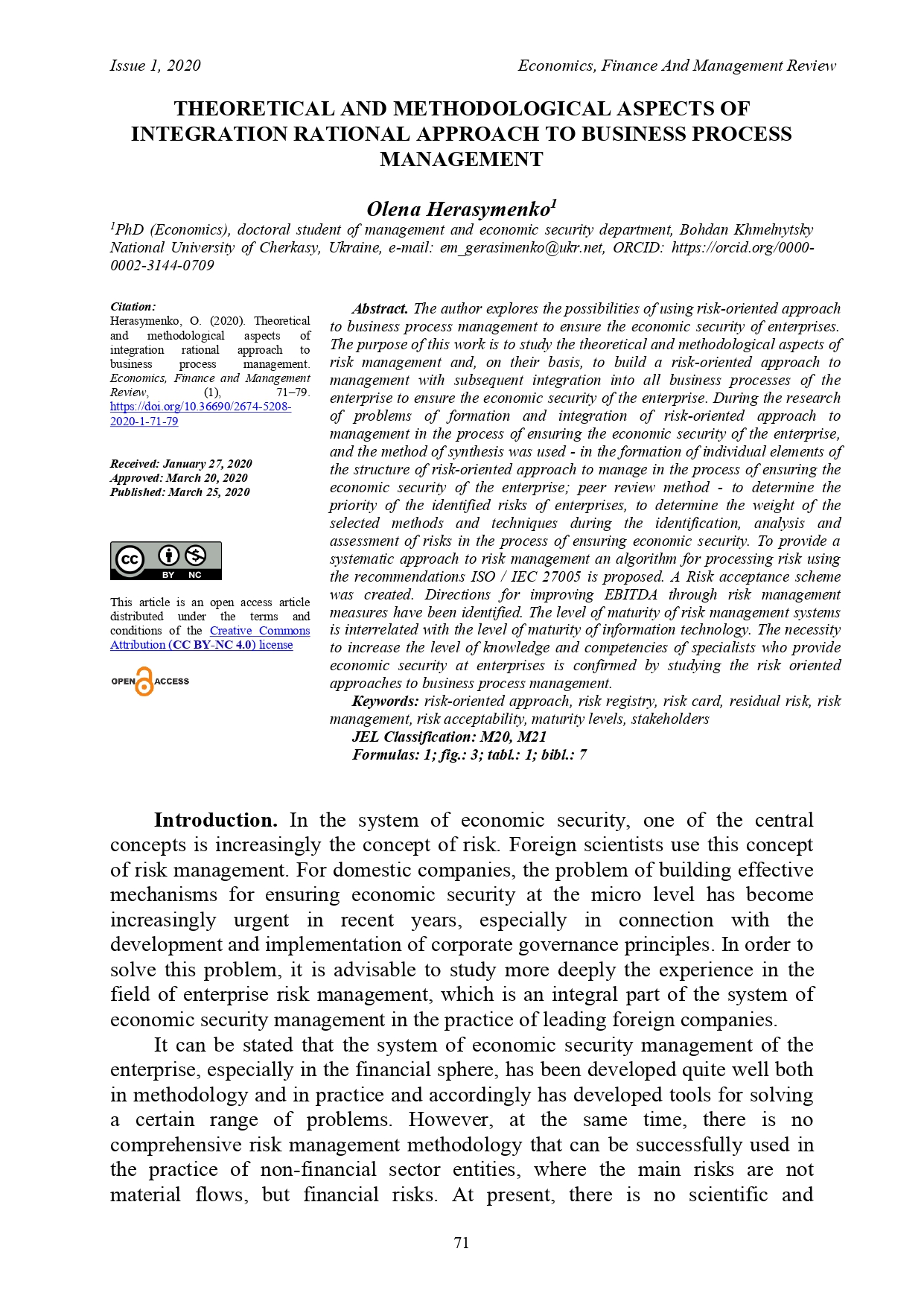THEORETICAL AND METHODOLOGICAL ASPECTS OF INTEGRATION RATIONAL APPROACH TO BUSINESS PROCESS MANAGEMENT
DOI:
https://doi.org/10.36690/2674-5208-2020-1-71-79Keywords:
risk-oriented approach, risk registry, risk card, residual risk, risk management, risk acceptability, maturity levels, stakeholdersAbstract
The author explores the possibilities of using risk-oriented approach to business process management to ensure the economic security of enterprises. The purpose of this work is to study the theoretical and methodological aspects of risk management and, on their basis, to build a risk-oriented approach to management with subsequent integration into all business processes of the enterprise to ensure the economic security of the enterprise. During the research of problems of formation and integration of risk-oriented approach to management in the process of ensuring the economic security of the enterprise, and the method of synthesis was used - in the formation of individual elements of the structure of risk-oriented approach to manage in the process of ensuring the economic security of the enterprise; peer review method - to determine the priority of the identified risks of enterprises, to determine the weight of the selected methods and techniques during the identification, analysis and assessment of risks in the process of ensuring economic security. To provide a systematic approach to risk management an algorithm for processing risk using the recommendations ISO / IEC 27005 is proposed. A Risk acceptance scheme was created. Directions for improving EBITDA through risk management measures have been identified. The level of maturity of risk management systems is interrelated with the level of maturity of information technology. The necessity to increase the level of knowledge and competencies of specialists who provide economic security at enterprises is confirmed by studying the risk oriented approaches to business process management.
Downloads
References
Agnvall, E., (2007), „Job Fairs Go Virtual“, HR Magazine, pp 85.
Bussness and Technologies Magazine „Internet ogledalo“, broj 186/2018, Internet ogledalo d.o.o., Beograd, pp 18-21.
Dessler, G., (2015), „Upravljanje ljudskim potencijalima“, 12. globalno izdanje, Mate d.o.o., Zagreb [in Serbian]
Digitalizacija u procesu zapošljavanja. Retrieved from: http://hrpartners.me/blog/digitalizacija-u-procesu-zaposljavanja [in Serbian]
China Daily Information Co (CDIC). Official site. Retrieved from: http://www.chinadaily.com.cn/business/tech
Computers and the Future of Skill Demand. Retrieved from: https://read.oecd-ilibrary.org/education/computers-and-the-future-of-skill-demand_9789264284395-en#page13
In the War for Talent, the Best HR Tech Will Win. This Company Is Banking on It. Retrieved from: https://www.inc.com/emily-canal/twine-human-resources-software-data-metrics-evernote-30-under-30-2019.html.
Kovačević, I., (2013), “Users efficeincy, effectiveness, cognitive style and emotional reactions to computer interface based on different data models“, Doctoral Dissertation, University of Belgrade, Facultu of Philosophy [in Serbian].
Moroko, L., Uncles, M. D., (2008) „Characteristics of successful employer brands“, Emerald Management Reviews, Vol 16, 3, pp 160–175.
Ruiz, G., (2007), „Firms Tapping Web Videos to Lure Jobseekers“, Workforce Management, pp12.
Schwab, K. (2016), “The Fourth Industrial Revolution”, World Economic Forum, www.weforum.org.

Downloads
Published
How to Cite
Issue
Section
License

This work is licensed under a Creative Commons Attribution-NonCommercial 4.0 International License.








